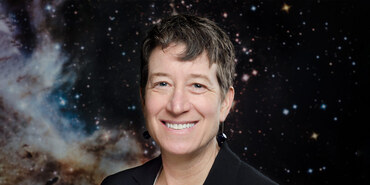Letter from the Interim Director
Dr. Nancy Levenson reflects on Hubble and Webb’s scientific discoveries, Roman’s milestones, and shares details about two new large observing programs.

Letter from the Interim Director
Dr. Nancy Levenson reflects on Hubble and Webb’s scientific discoveries, Roman’s milestones, and shares details about two new large observing programs.
Building an Ultraviolet Legacy
Hubble team members reflect on the completion of one of the telescope’s most ambitious observation programs and the impact it’s already having in astronomy.
One for the Record Books
The institute and astronomy community began shifting from the thrill of Webb’s beginnings to the new reality of a successfully operating science mission.
Charting a Course for the Cloud
Building software for Roman’s Science Operations Center is a balance between innovating and borrowing from existing systems.
For the People
Our archive staff saw an increased adoption of the accessible tools and search forms they now regularly release, lowering barriers to research and accelerating discovery.
In Search of Habitable Worlds
Staff in STScI’s Russell B. Makidon Optics Laboratory are actively advancing instruments designed to find and study Earth-like planets.
Shifting to a Faster Tempo
Our engineers have fine-tuned data processing, evoking a chord of speed and efficiency.
In the News
Hubble and Webb made headlines throughout the year.
Research at the Forefront
The wide array of peer-reviewed articles by our staff and their collaborators contribute to a growing body of research that supports the institute’s operations and the worldwide astronomy community.
Sharing Our Universe
Our multi-disciplinary public engagement staff worked together to create new, accessible products and host events for the public.
‘Ordinary’ Champions
Mentorships help our staff develop a greater sense of belonging and cultivate work satisfaction, positively influencing the institute’s culture.
By the Numbers
Demand to use the Hubble and James Webb space telescopes remains high.
Meet Our Staff
Jenn Kotler designs products that give researchers freedom and control, no matter how they access the content, and Jonathan Cecil works alongside a team to regularly assess and upgrade our office buildings.
Want to know more about the institute’s missions, divisions, and initiatives? Filter by topic, year, or keyword to explore the institute’s accomplishments since 1999.
Dr. Nancy Levenson reflects on Hubble and Webb’s scientific discoveries, Roman’s milestones, and shares details about two new large observing programs.

Hubble team members reflect on the completion of one of the telescope’s most ambitious observation programs and the impact it’s already having in astronomy.

The institute and astronomy community began shifting from the thrill of Webb’s beginnings to the new reality of a successfully operating science mission.

Building software for Roman’s Science Operations Center is a balance between innovating and borrowing from existing systems.

Our archive staff saw an increased adoption of the accessible tools and search forms they now regularly release, lowering barriers to research and accelerating discovery.

Staff in STScI’s Russell B. Makidon Optics Laboratory are actively advancing instruments designed to find and study Earth-like planets.

Our engineers have fine-tuned data processing, evoking a chord of speed and efficiency.


The wide array of peer-reviewed articles by our staff and their collaborators contribute to a growing body of research that supports the institute’s operations and the worldwide astronomy community.

Our multi-disciplinary public engagement staff worked together to create new, accessible products and host events for the public.

Mentorships help our staff develop a greater sense of belonging and cultivate work satisfaction, positively influencing the institute’s culture.

Demand to use the Hubble and James Webb space telescopes remains high.

Dr. Nancy Levenson marks the beginning of Webb’s operations, Hubble’s ongoing discoveries, Roman’s milestones, and underlines how our staff continues to support the astronomical community.

A behind-the-scenes account of the James Webb Space Telescope’s first year.

Throughout its first year in space, the James Webb Space Telescope exceeded expectations.
